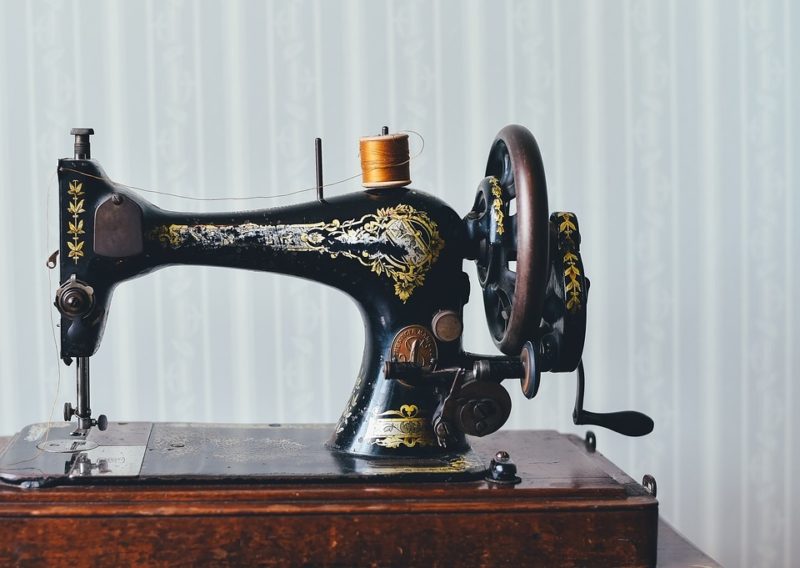The answer to what is a rotary sewing machine is that it’s a machine where the hook rotates around a bobbin in a full circle. We’ll discuss how it works in more detail to help you differentiate it from a sewing machine that uses an oscillating system. And of course, you’ll learn how to use it.
Speaking of rotary, read how to thread a White Rotary sewing machine if you’re interested in this machine type. Setting it up properly is crucial to avoid issues when sewing.

What Is A Rotary Sewing Machine Vs Oscillating Hook
Sewing machines can come in different hook systems, and a rotary sewing machine is so-called because its hook rotates around a stationary bobbin to a full circle. It is also sometimes called a rotary hook sewing machine and a full rotary sewing machine. And because of its design, the shuttle hook catches the tread when the needle moves, while the hook is responsible for carrying the thread around the bobbin to form a stitch.
Pros of a rotary sewing machine
- Runs at high speeds without vibrating
- Relatively quiet regardless of the speed
- Doesn’t experience thread jamming often
- Ideal for industrial sewing
Cons of a rotary sewing machine
- The precision setting is crucial to keep the gear linkage between the top and bottom shafts working smoothly
- Timing adjustment is done more often
- Tight thread tolerance
How Do Rotary Sewing Machines Work?
The hook system of a rotary sewing machine has the hook traveling continuously in one direction as it carries the top thread around the bobbin case. Then as the needle comes down, the take-up lever positions itself to lift the top thread and tighten the stitch. Let us compare the rotary hook to the oscillating hook to understand further how rotary sewing machines work.
Rotary hook sewing machine vs oscillating hook sewing machine
In a sewing machine that uses an oscillating system, the hook picks the top thread but won’t carry it around the bobbin completely. Instead, it takes the loop past the center, so the needle pressure can pull the thread up and have the loop off the hook. Then, similar to the rotary hook system, the loop will still travel and wrap the bobbin thread.
Which sewing machine to choose: rotary hook or oscillating hook?
The oscillating hook sewing machine is ideal for beginners because it is straightforward, so someone inexperienced can’t accidentally damage it. It is also low maintenance, and the settings are not overwhelming for beginners. However, if you want something more powerful, opt for a horizontal rotary hook sewing machine.
This type comes with various applicable settings that would be perfect for experienced sewers that want to maximize their creativity. And if you want a professional sewing machine, the best one to get is a vertical rotary hook model. They are suitable for industrial use but expect a higher price point.
Finally, remember that a hook can either face toward the side or toward the front. The former is called the vertical hook, and the latter is the horizontal hook. Choosing between them will depend on which the user finds the more convenient when loading the bobbin.
How To Use A Rotary Sewing Machine
Before anything else, refer to the manual of the specific sewing machine you have. The following are applicable to a White Rotary sewing machine:
Setting the needle
- Raise the needle bar as much as you can and loosen the thumbscrew
- Press the screw to the left and insert the new needle as far as you can into position with its flat side to the right
- Tighten the screw to fasten the needle in place
Read about how to put a needle in a sewing machine for a more in-depth guide.
Winding and threading the bobbin
- Put the spool to its pin and thread the hole in the cover plate
- Guide the thread to the left under and over to reach the front hole
- Thread the bobbin inside out
- Put the bobbin on the winding spindle and engage winding
- Put the bobbin to its case and pass the thread through the opening and under the lip
- Thread the tension spring
Threading the upper thread
- Put the thread spool to its pin and lead the thread over the check spring and notch indicated on the illustrations in the manual
- Thread the notch and slot illustrated until you can go through the needle eye left to right
- Leave about three inches of thread
- Raise the presser foot and hold the upper thread end
- Turn the handwheel to draw the lower thread up
Adjusting the tension
- Turn the dial to the left to loosen the tension
- Turn the dial to the right to tighten the tension
What Is Rotary Stitch?
The lockstitch stitches made by a rotary hook sewing machine will look exactly like those made by an oscillating hook sewing machine. Furthermore, there is no difference in the stitch’s strength produced by the two sewing machine types. However, rotary sewing machines are more preferred for industrial work because of their output and capacity.
Conclusion
The answer to what is a rotary sewing machine is it refers to the type of hook system that the machine uses. Compared to an oscillating hook sewing machine, a rotary machine has its hook rotating in a complete circle around the bobbin. Therefore, it is also ideal for demanding sewing projects without fearing jamming and other issues.
We hope this was a helpful read. Leave us a comment if you have any.
